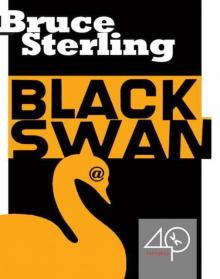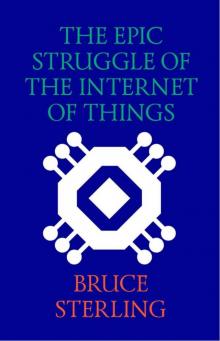- Home
- Bruce Sterling
Mirrorshades: The Cyberpunk Anthology Page 3
Mirrorshades: The Cyberpunk Anthology Read online
Page 3
I did worry about it, though.
Kihn combed his thinning blond hair and went off to hear what They had had to say over the radar range lately, and I drew the curtains in my room and lay down in air-conditioned darkness to worry about it. I was still worrying about it when I woke up. Kihn had left a note on my door; he was flying up north in a chartered plane to check out a cattle-mutilation rumor (‘muties,’ he called them; another of his journalistic specialties).
I had a meal, showered, took a crumbling diet pill that had been kicking around in the bottom of my shaving kit for three years, and headed back to Los Angeles.
The speed limited my vision to the tunnel of the Toyota’s headlights. The body could drive, I told myself, while the mind maintained. Maintained and stayed away from the weird peripheral window dressing of amphetamine and exhaustion, the spectral, luminous vegetation that grows out of the corners of the mind’s eye along late-night highways. But the mind had its own ideas, and Kihn’s opinion of what I was already thinking of as my ‘sighting’ rattled endlessly through my head in a tight, lopsided orbit. Semiotic ghosts. Fragments of the Mass Dream, whirling past in the wind of my passage. Somehow this feedback-loop aggravated the diet pill, and the speed-vegetation along the road began to assume the colors of infrared satellite images, glowing shreds blown apart in the Toyota’s slipstream.
I pulled over, then, and a half-dozen aluminium beer cans winked goodnight as I killed the headlights. I wondered what time it was in London, and tried to imagine Dialta Downes having breakfast in her Hampstead flat, surrounded by streamlined chrome figurines and books on American culture.
Desert nights in that country are enormous; the moon is closer. I watched the moon for a long time and decided that Kihn was right. The main thing was not to worry. All across the continent, daily, people who were more normal than I’d ever aspired to be saw giant birds, Bigfeet, flying oil refineries; they kept Kihn busy and solvent. Why should I be upset by a glimpse of the 1930s pop imagination loose over Bolinas? I decided to go to sleep, with nothing worse to worry about than rattlesnakes and cannibal hippies, safe amid the friendly roadside garbage of my own familiar continuum. In the morning I’d drive down to Nogales and photograph the old brothels, something I’d intended to do for years. The diet pill had given up.
The light woke me, and then the voices.
The light came from somewhere behind me and threw shifting shadows inside the car. The voices were calm, indistinct, male and female, engaged in conversation.
My neck was stiff and my eyeballs felt gritty in their sockets. My leg had gone to sleep, pressed against the steering wheel. I fumbled for my glasses in the pocket of my work shirt and finally got them on.
Then I looked behind me and saw the city.
The books on Thirties design were in the trunk; one of them contained sketches of an idealized city that drew on Metropolis and Things to Come, but squared everything, soaring up through an architect’s perfect clouds to zeppelin docks and mad neon spires. That city was a scale model of the one that rose behind me. Spire stood on spire in gleaming ziggurat steps that climbed to a central golden temple tower ringed with the crazy radiator flanges of the Mongo gas stations. You could hide the Empire State Building in the smallest of those towers. Roads of crystal soared between the spires, crossed and recrossed by smooth silver shapes like beads of running mercury. The air was thick with ships: giant wing-liners, little darting silver things (sometimes one of the quicksilver shapes from the sky bridges rose gracefully into the air and flew up to join the dance), mile-long blimps, hovering dragonfly things that were gyrocopters…
I closed my eyes tight and swung around in the seat. When I opened them, I willed myself to see the mileage meter, the pale road dust on the black plastic dashboard, the overflowing ashtray.
‘Amphetamine psychosis,’ I said. I opened my eyes. The dash was still there, the dust, the crushed filtertips. Very carefully, without moving my head, I turned the headlights on.
And saw them.
They were blond. They were standing beside their car, an aluminum avocado with a central shark-fin rudder jutting up from its spine and smooth black tires like a child’s toy. He had his arm around her waist and was gesturing toward the city. They were both in white: loose clothing, bare legs, spotless white sun shoes. Neither of them seemed aware of the beams of my headlights. He was saying something wise and strong, and she was nodding, and suddenly I was frightened, frightened in an entirely different way. Sanity had ceased to be an issue; I knew somehow, that the city behind me was Tucson—a dream Tucson thrown up out of the collective yearning of an era. That it was real, entirely real. But the couple in front of me lived in it, and they frightened me.
They were the children of Dialta Downes’s ’80-that-wasn’t; they were Heirs to the Dream. They were white, blond, and they probably had blue eyes. They were American. Dialta had said that the Future had come to America first, but had finally passed it by. But not here, in the heart of the Dream. Here, we’d gone on and on, in a dream logic that knew nothing of pollution, the finite bounds of fossil fuel, or foreign wars it was possible to lose. They were smug, happy, and utterly content with themselves and their world. And in the Dream, it was their world.
Behind me, the illuminated city: Searchlights swept the sky for the sheer joy of it. I imagined them thronging the plazas of white marble, orderly and alert, their bright eyes shining with enthusiasm for their floodlit avenues and silver cars.
It had all the sinister fruitiness of Hitler Youth propaganda.
I put the car in gear and drove forward slowly, until the bumper was within three feet of them. They still hadn’t seen me. I rolled the window down and listened to what the man was saying. His words were bright and hollow as the pitch in some Chamber of Commerce brochure, and I knew that he believed in them absolutely.
‘John,’ I heard the woman say, ‘we’ve forgotten to take our food pills.’ She clicked two bright wafers from a thing on her belt and passed one to him. I backed onto the highway and headed for Los Angeles, wincing and shaking my head.
I phoned Kihn from a gas station. A new one, in bad Spanish Modern. He was back from his expedition and didn’t seem to mind the call.
‘Yeah, that is a weird one. Did you try to get any pictures? Not that they ever come out, but it adds an interesting frisson to your story, not having the pictures turn out…’
But what should I do?
‘Watch lots of television, particularly game shows and soaps. Go to porn movies. Ever see Nazi Love Motel? They’ve got it on cable, here. Really awful. Just what you need.’
What was he talking about?
‘Quit yelling and listen to me. I’m letting you in on a trade secret: Really bad media can exorcise your semiotic ghosts. If it keeps the saucer people off my back, it can keep these Art Deco futuroids off yours. Try it. What have you got to lose?’
Then he begged off, pleading an early-morning date with the Elect.
‘The who?’
‘These oldsters from Vegas; the ones with the microwaves.’
I considered putting a collect call through to London, getting Cohen at Barris-Watford and telling him hisphotographer was checking out for a protracted season in the Twilight Zone. In the end, I let a machine mix me a really impossible cup of black coffee and climbed back into the Toyota for the haul to Los Angeles.
Los Angeles was a bad idea, and I spent two weeks there. It was prime Downes country; too much of the Dream there, and too many fragments of the Dream waiting to snare me. I nearly wrecked the car on a stretch of overpass near Disneyland, when the road fanned out like an origami trick and left me swerving through a dozen minilanes of whizzing chrome teardrops with shark fins. Even worse, Hollywood was full of people who looked too much like the couple I’d seen in Arizona. I hired an Italian director who was making ends meet doing darkroom work and installing patio decks around swimming pools until his ship came in; he made prints of all the
negatives I’d accumulated on the Downes job. I didn’t want to look at the stuff myself. It didn’t seem to bother Leonardo, though, and when he was finished I checked the prints, riffling through them like a deck of cards, sealed them up, and sent them air freight to London. Then I took a taxi to a theater that was showing Nazi Love Motel, and kept my eyes shut all the way.
Cohen’s congratulatory wire was forwarded to me in San Francisco a week later. Dialta had loved the pictures. He admired the way I’d ‘really gotten into it,’ and looked forward to working with me again. That afternoon I spotted a flying wing over Castro Street, but there was something tenuous about it, as though it were only half there. I rushed into the nearest newstand and gathered up as much as I could find on the petroleum crisis and the nuclear energy hazard. I’d just decided to buy a plane ticket for New York.
‘Hell of a world we live in, huh?’ The proprietor was a thin black man with bad teeth and an obvious wig. I nodded, fishing in my jeans for change, anxious to find a park bench where I could submerge myself in hard evidence of the human near-dystopia we live in. ‘But it could be worse, huh?’
‘That’s right,’ I said, ‘or even worse, it could be perfect.’
He watched me as I headed down the street with my little bundle of condensed catastrophe.
TOM MADDOX
* * *
Snake-Eyes
* * *
By 1986 the new Eighties esthetic was in full swing. Its current state of the art is brilliantly represented by this story from Virginia writer Tom Maddox.
Tom Maddox is an assistant professor of languages and literature at Virginia State University. He is not a prolific writer, his output to date a bare handful of short stories. Yet his mastery of the cyberpunk dynamic is unsurpassed.
In this fast-paced, intensely visionary story, Maddox moves swiftly and incisively across a broad range of the Movement's themes and obsessions. "Snake-Eyes" stands as a definitive example of modern hard-core cyberpunk.
Dark meat in the can—brown, oily, and flecked with mucus—gave off a repellent, fishy smell, and the taste of it rose in his throat, putrid and bitter, like something from a dead man’s stomach. George Jordan sat on the kitchen floor and vomited, then pushed himself away from the shining pool, which looked very much like what remained in the can.
He thought, No, this won’t do: I have wires in my head, and they make me eat cat food. The snake likes cat food.
He needed help but know there was little point in calling the Air Force. He’d tried them, and there was no way they were going to admit responsibility for the monster in his head. What George called the snake, the Air Force called Effective Human Interface Technology and didn’t want to hear about any postdischarge problems with it. They had their own problems with congressional committees investigating “the conduct of the war in Thailand.”
He lay for a while with his cheek on the cold linoleum, got up and rinsed his mouth in the sink, then stuck his head under the faucet and ran cold water over it, thinking, Call the goddamned multicomp, then call SenTrax and say, “Is it true you can do something about this incubus that wants to take possession of my soul?” And if they ask you, “What’s your problem?” you say “cat food,” and maybe they’ll say, “Hell, it just wants to take possession of your lunch”.
A chair covered in brown corduroy stood in the middle of the barren living room, a white telephone on the floor beside it, a television flat against the opposite waIl—that was the whole thing, what might have been home, if it weren’t for the snake.
He picked up the phone, called up the directory on its screen, and keyed TELECOM SENTRAX.
The Orlando Holiday Inn stood next to the airport terminal, where tourists flowed in eager for the delights of Disney World. But for me, George thought, there are no cute, smiling ducks and rodents. Here as everywhere, it’s Snake city.
From the window of his motel room, he watched gray sheets of rain cascade across the pavement. He had been waiting two days for a launch. At Canaveral a shuttle sat on its pad, and when the weather cleared, a helicopter would pick him up and drop him there, a package for delivery to SenTrax, Inc., at Athena Station, over thirty thousand kilometers above the equator.
Behind him, under the laser light of a Blaupunkt holestage, people a foot high chattered about the war in Thailand and how lucky the United States had been to escape another Vietnam.
Lucky? Maybe … he had been wired up and ready for combat training, already accustomed to the form-fitting contours in the rear couch of the black, tiber-bodied General Dynamics A-230. The A-230 flew on the deadly edge of instability, every control surface monitored by its own bank of micro-computers, all hooked into the snakebrain flight-and-tire assistant with the twin black miloprene cables running from either side of his esophagus—getting off, oh yes, when the cables snapped home, and the airframe resonated through his nerves, his body singing with that identity, that power.
Then Congress pulled the plug on the war, the Air Force pulled the plug on George, and when his discharge came, there he was, lett with technological blue balls and this hardware in his head that had since taken on a life of its own.
Lightning walked across the purpled sky, ripping it, crazing it into a giant, upturned bowl of shattered glass. Another foot-high man on the holostage said the tropical storm would pass in the next two hours.
Hamilton Innis was tall and heavy—six four and about two hundred and fifty pounds. Wearing a powder-blue jump-suit with SENTRAX in red letters down its left breast, and soft black slippers, he floated in a brightly lit white corridor, held gingerly to a wall by one of the jumpsuit’s Velcro patches. A view-screen above the airlock entry showed the shuttle fitting its nose into the docking tube. He waited for it to mate to the airlock hatches and send in the newest candidate.
This one was six months out of the service and slowly losing what the Air Force doctors had made of his mind. Former tech sergeant George Jordan—two years’ community college in Oakland, California, followed by enlistment in the Air Force, aircrew training, the EHIT program. According to the profile Aleph had put together from Air Force records and the National Data Bank, a man with slightly above-average aptitudes and intelligence, a distinctly above-average taste for the bizarre—thus his volunteering for EHIT and combat. In his file pictures, he looked nondescript—five ten, a hundred and seventy-six pounds, brown hair and eyes, neither handsome nor ugly. But it was an old picture and could not show the snake and the fear that came with it. You don’f know it, buddy, Innis thought, but you ain’t seen nothing yet.
The man came tumbling through the hatch, more or less helpless in free fall, but Innis could see him figuring it out, willing the muscles to quit struggling, quit trying to cope with a gravity that simply wasn’t there. “What the hell do I do now?” George Jordan asked, hanging in midair, one arm holding on to the hatch coaming.
“Relax. I’ll get you.” Innis pushed off and swooped across, grabbing the man as he passed, taking them both to the opposite wall and kicking to carom them outward.
lnnis gave George a few hours of futile attempts at sleep—enough time for the bright, gliding phosphenes caused by the high g’s of the trip up to disappear from his vision. George spent most of the time rolling around in his bunk, listening to the wheeze of the air-conditioning and creaks of the rotating station.
Then Innis knocked on his compartment door and said through the door speaker, “Come on, fella. Time to meet the doctor.”
They walked through an older part of the station, where there were brown clots of fossilized gum on the green plastic flooring, scuff marks on the walls, along with faint imprints of insignia and company names—ICON was repeated several times in ghost lettering. Innis told George it meant the now defunct International Construction Orbital Group, the original builders and controllers of Athena. Innis stopped George in front of a door that read INTERFACE GR0UP “Go on in,” he said. “I’ll be around a little later.”
Pictures of cranes drawn with delicate white strokes on a tan silk background hung along one pale cream wall. Curved partitions in trans-lucent foam, glowing with the soft lights placed behind them, marked a central area, then undulated away, forming a corridor that led into darkness. George was sitting on a chocolate sling couch; Charley Hughes lying back in a chrome and brown leatherette chair, his feet on the dark veneer table in front of him, a half inch of ash hanging from his cigarette end.
Hughes was not the usual M.D. clone. He was a thin figure in a worn gray obi, his black hair pulled back from sharp features into a waist-length ponytail, his face taut and a little wild-eyed.
“Tell me about the snake,” Hughes said.
“What do you want to know? It’s an implanted mikey-mike nexus—”
“Yes, I know that. It’s unimportant. Tell me about your experience.” Ash dropped off the cigarette onto the brown mat floor covering. “Tell me why you’re here.”
“Okay I had been out of the Air Force for a month or so, had a place close to Washington, in Silver Spring. I thought I’d try to get some airline work, but I was in no real hurry because I had about six months of post-discharge bennies coming, and I thought I’d take it easy for a while.
“At first there was just this nonspecific weirdness. I felt distant, disconnected, but what the hell? Living in the USA, you know? Anyway I was just sitting around one evening, I was gonna watch a little holo-v, drink a few beers. Oh man, this is hard to explain. I felt real funny—like maybe I was having, I don’t know, a heart attack or a stroke. The words on the holo didn’t make any sense, and it was like I was seeing everything underwater. Then I was in the kitchen pulling things out of the refrigerator—lunch meat, raw eggs, butter, beer, all kinds of crap. I just stood there and slammed it all down. Cracked the eggs and sucked them right out of the shell, ate the butter in big chunks, all the bologna, drank all the beer—one, two, three, just like that.”

 Mirrorshades: The Cyberpunk Anthology
Mirrorshades: The Cyberpunk Anthology The Wonderful Power of Storytelling
The Wonderful Power of Storytelling Love Is Strange (A Paranormal Romance)
Love Is Strange (A Paranormal Romance) Globalhead
Globalhead Essays. FSF Columns
Essays. FSF Columns The Hacker Crackdown
The Hacker Crackdown Bicycle Repairman
Bicycle Repairman Black Swan
Black Swan Crystal Express
Crystal Express Islands in the Net
Islands in the Net Pirate Utopia
Pirate Utopia GURPS' LABOUR LOST
GURPS' LABOUR LOST The Dead Media Notebook
The Dead Media Notebook Unstable Networks
Unstable Networks The Manifesto of January 3, 2000
The Manifesto of January 3, 2000 Heavy Weather
Heavy Weather Involution Ocean
Involution Ocean The Epic Struggle of the Internet of Things
The Epic Struggle of the Internet of Things A Good Old-Fashioned Future
A Good Old-Fashioned Future The Littlest Jackal
The Littlest Jackal Zeitgeist
Zeitgeist Totem Poles
Totem Poles Ascendancies
Ascendancies CyberView 1991
CyberView 1991 War Is Virtual Hell
War Is Virtual Hell Taklamakan
Taklamakan Holy Fire
Holy Fire Cyberpunk in the Nineties
Cyberpunk in the Nineties Schismatrix Plus
Schismatrix Plus The Artificial Kid
The Artificial Kid Essays. Catscan Columns
Essays. Catscan Columns Maneki Neko
Maneki Neko Distraction
Distraction In Paradise
In Paradise Red Star, Winter Orbit
Red Star, Winter Orbit Luciferase
Luciferase